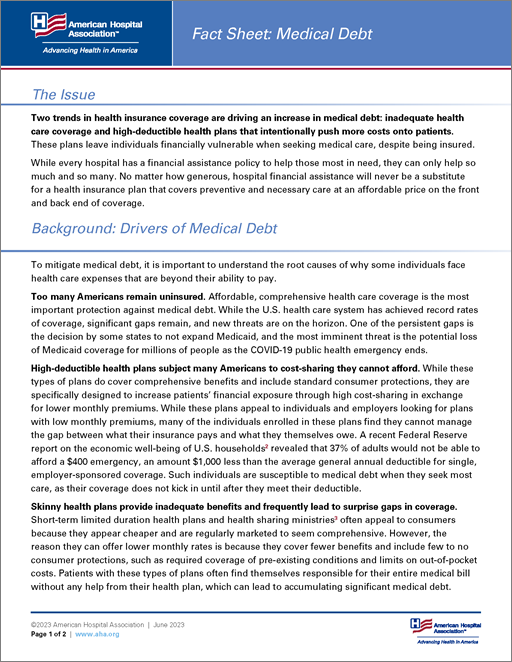Fact Sheet: Medical Debt
June 2023
The Issue
Two trends in health insurance coverage are driving an increase in medical debt: inadequate health care coverage and high-deductible health plans that intentionally push more costs onto patients. These plans leave individuals financially vulnerable when seeking medical care, despite being insured.
While every hospital has a financial assistance policy to help those most in need, they can only help so much and so many. No matter how generous, hospital financial assistance will never be a substitute for a health insurance plan that covers preventive and necessary care at an affordable price on the front and back end of coverage.
Background: Drivers of Medical Debt
To mitigate medical debt, it is important to understand the root causes of why some individuals face health care expenses that are beyond their ability to pay.
Too many Americans remain uninsured. Affordable, comprehensive health care coverage is the most important protection against medical debt. While the U.S. health care system has achieved record rates of coverage, significant gaps remain, and new threats are on the horizon. One of the persistent gaps is the decision by some states to not expand Medicaid, and the most imminent threat is the potential loss of Medicaid coverage for millions of people as the COVID-19 public health emergency ends.
High-deductible health plans subject many Americans to cost-sharing they cannot afford. While these types of plans do cover comprehensive benefits and include standard consumer protections, they are specifically designed to increase patients’ financial exposure through high cost-sharing in exchange for lower monthly premiums. While these plans appeal to individuals and employers looking for plans with low monthly premiums, many of the individuals enrolled in these plans find they cannot manage the gap between what their insurance pays and what they themselves owe. A recent Federal Reserve report on the economic well-being of U.S. households2 revealed that 37% of adults would not be able to afford a $400 emergency, an amount $1,000 less than the average general annual deductible for single, employer-sponsored coverage. Such individuals are susceptible to medical debt when they seek most care, as their coverage does not kick in until after they meet their deductible.
Skinny health plans provide inadequate benefits and frequently lead to surprise gaps in coverage. Short-term limited duration health plans and health sharing ministries3 often appeal to consumers because they appear cheaper and are regularly marketed to seem comprehensive. However, the reason they can offer lower monthly rates is because they cover fewer benefits and include few to no consumer protections, such as required coverage of pre-existing conditions and limits on out-of-pocket costs. Patients with these types of plans often find themselves responsible for their entire medical bill without any help from their health plan, which can lead to accumulating significant medical debt.
AHA Take
Hospitals and health systems have long been strong proponents of comprehensive coverage and will continue to advance solutions that make care and coverage more affordable and accessible for all patients. Hospitals’ doors are always open to anyone who needs care, regardless of ability to pay. Hospitals and health systems of all types provided more than $42 billion in uncompensated care — care for which they received no payment— in 2020 alone. However, the root causes of medical debt are primarily a result of problems with inadequate health care coverage. Health plans must do their part by ensuring that the coverage they offer provides protection against unaffordable bills and medical debt.
Proposed Solutions
We must tackle the problem of medical debt, and we must do so at the root: ensuring all individuals are enrolled in comprehensive health care coverage with affordable cost-sharing.
Solutions include:
- Restricting the sale of high-deductible health plans to only those individuals with the demonstrated means to afford the associated cost-sharing.
- Prohibiting the sale of health sharing ministry products and short-term limited duration plans that go longer than 90 days.
- Lowering the maximum out-of-pocket cost-sharing limits.
- Eliminating the use of deductibles and co-insurance and relying solely on flat co-payments, which are easier for patients to anticipate and for providers to administer.
- Removing providers from the collection of cost-sharing altogether by requiring health plans collect directly from their enrollees the cost-sharing payments they impose. This approach would eliminate most patient bills from providers altogether.
In addition, due to hospitals’ and health systems’ commitment to improving the health care consumer experience and creating a more equitable care experience, the AHA has actively engaged in identifying and promoting best practices in patient billing for decades. The AHA most recently updated our voluntary patient billing guidance in 2020. The guidelines address issues such as assisting patients who cannot pay for the care they receive and protecting patients from certain debt collection practices, such as garnishment of wages, liens, interest on debt, adverse credit reporting and lawsuits. Most hospitals provide free care for patients with the most limited means, as defined by income below 200% of the federal poverty limit. In the event of an unpaid bill, the Internal Revenue Service has prescribed an extensive series of steps and wait times that most hospitals must adhere to before taking any collection actions, which is a last resort.
__________
1 Peterson-KFF Health System Tracker, The Burden of Medical Debt in the United States. March 10, 2022.
2 Federal Reserve, Report on the Economic Well-Being of U.S. Households in 2019. May 2020.
3 Health sharing ministries are organizations in which members share a common set of ethical or religious beliefs and pay regular contributions to the ministry to cover members’
medical expenses in accordance with those beliefs. Health sharing ministries are not a form of insurance.


